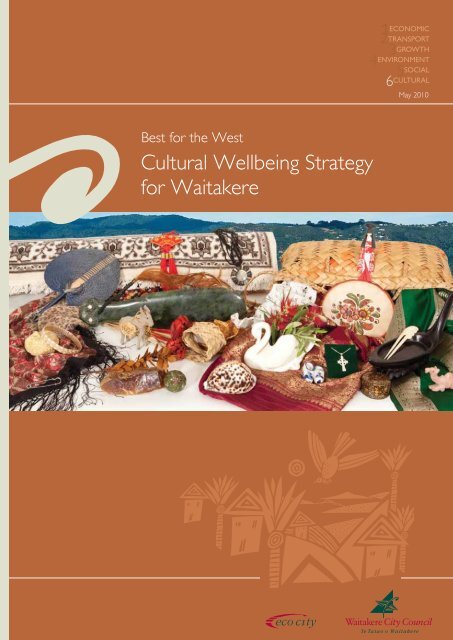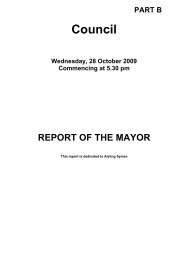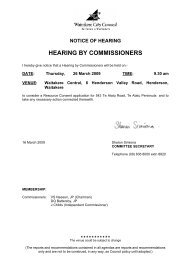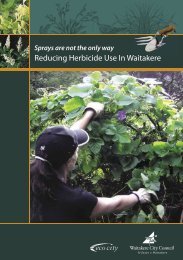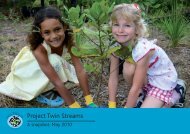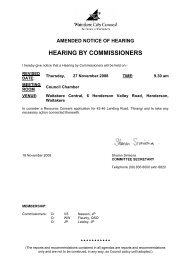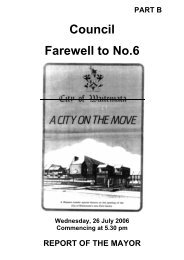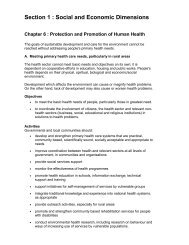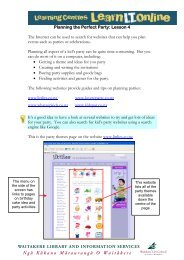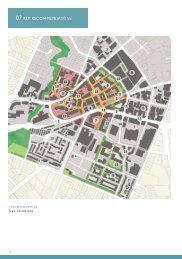Cultural Wellbeing Strategy for Waitakere - Auckland Council
Cultural Wellbeing Strategy for Waitakere - Auckland Council
Cultural Wellbeing Strategy for Waitakere - Auckland Council
- No tags were found...
Create successful ePaper yourself
Turn your PDF publications into a flip-book with our unique Google optimized e-Paper software.
celebration creativity<strong>Waitakere</strong> Wayethnic diversity a work of artvibrant treasured heritagenatural taonga city shapingTHE STRATEGIC FRAMEWORK FORCULTURAL WELLBEING 2THE EXECUTIVE SUMMARY 3PATHWAYS AND ACTIONS 5SECTION ONECULTURAL WELLBEING 6Background 6Introduction 7Describing cultural wellbeing 8<strong>Cultural</strong> wellbeing and sustainability 10<strong>Waitakere</strong> in 2009 and the challenges of change 11Westies and the ‘<strong>Waitakere</strong> Way’ 12Purpose 15Scope and <strong>Council</strong>’s role in cultural wellbeing 16Strategic links 18Contribution to community outcomes 18Guiding principles 19Outcomes, pathways and action areas 19The outcomes - what would they look like on theground? 20Seven strategic pathways and action areas 22Measuring cultural wellbeing over time 24SECTION THREEAPPENDICES 25Glossary 25References 26SECTION TWOTHE STRATEGIC DIRECTION 14The need <strong>for</strong> a cultural wellbeing strategy <strong>for</strong> <strong>Waitakere</strong> 14CONTENTSBEST FOR THE WEST - CULTURAL WELLBEING STRATEGY FOR WAITAKERE 1
THE STRATEGIC FRAMEWORK FORCULTURAL WELLBEINGVISIONWe all feel we belong, treasuring our diversity, creativity,culture and heritageSTRATEGICOUTCOMESVibrant celebratingcommunityDiverse-City:Knowing our pastand who we areVibrant sustainableenvironment of artsand cultural activityOur heritage isidentified, protectedand promotedWHATWILL BEDONE?Enable the provisionof artistic, cultural,leisure and learningactivities andinfrastructureFoster a creative Cityand economySupport diverseidentities and culturesto be expressed andcelebratedSupport individualartistsSupport organisationsSupport projects,programmes andactivitiesSupport venues andsitesAdvocate <strong>for</strong> heritagegoalsSupport, maintainand protect significantheritage archivalmaterials and featuresAdvocate <strong>for</strong> heritageconsideration inplanning processesSupport activities totell our storiesWork with Iwi partnersand local communitySECTION THE STRATEGIC ONE ???????? FRAMEWORK FOR CULTURAL WELLBEINGHOWWILL IT BEDONE? 1COUNCILACTIVITYAREASLocal eventsprovision andsupportPacifi c artsdevelopment atCorban EstateCreative sectorsplanning<strong>Cultural</strong> celebrationsand events supportSettlement SupportMulti-lingual bookcollectionSocial and <strong>Cultural</strong> <strong>Strategy</strong>West Wave Aquatic and Recreation CentreLibrary ServicesResource ManagementLopdell House and<strong>Waitakere</strong> Artsand Culture Trustoperational supportArts <strong>Council</strong> supportPlayhouse andTitirangi TheatresupportArts projects in civicconstructionsArts, Events and CommunicationsLeisure ServicesParks and Open SpacesStrategic PlanningLopdell HouseredevelopmentHeritage buildingprojectsOral and archivalhistory collectionsIwi consultation andengagement1 Examples of <strong>Council</strong>’s key projects2 BEST FOR THE WEST - CULTURAL WELLBEING STRATEGY FOR WAITAKERE
THE EXECUTIVE SUMMARYHenna application, Diwali FestivalCommunity garden, RanuiTiakina Te Wao Nui A Tiriwa Hei Oranga MouTreasure the vast domain of Tiriwa and in turn you shall benefitTiriwa is an early ancestor of this area and the old name <strong>for</strong> the whole ofwest <strong>Auckland</strong> was Te Wao Nui A Tiriwa, the great <strong>for</strong>est of Tiriwa.GUIDING PRINCIPLESThe Treaty of Waitangi sets New Zealand’s cultural contextwhich <strong>for</strong>mally recognises the relationship between twonations, te iwi Maori and the Crown.A core value underpinning the strategy is that diverse culturalvalues strengthen our wellbeing. The <strong>Council</strong> is more likely tocontribute to improved cultural wellbeing outcomes if it:1. works in a manner that actively promotes culturalinclusion and takes account of the diversity of thecommunities living in <strong>Waitakere</strong>2. develops effective mechanisms <strong>for</strong> engaging with a widevariety of different communities3. actively seeks ways to reduce the barriers that peoplefrom different communities experience in accessingservices and facilities in the City4. develops an in-depth understanding of the sociodemographiccharacteristics of the neighbourhoods andcommunities in the City, including the challenges facingthem and the resources available to them5. fosters the pioneering, innovative, creative, risk taking,‘Westie’ mentality6. focuses on what will unite and connect people whenconsidering issues and making decisions7. brings cultural leaders and leadership to the <strong>for</strong>e indeveloping our City8. acknowledges the fundamental role of places,experiences, history, spirituality, and natural and culturalheritage in shaping our culture and identityThe six cultural wellbeing strategy outcomes are in<strong>for</strong>medby these guiding principles and the cultural wellbeing visionand then integrated into the <strong>Council</strong>’s seven pathways, whichfollow.THE EXECUTIVE SUMMARYBEST FOR THE WEST - CULTURAL WELLBEING STRATEGY FOR WAITAKERE 3
SECTION ONE:CULTURAL WELLBEINGEco Day per<strong>for</strong>mersLopdell House art centreBACKGROUND<strong>Waitakere</strong>’s strategic framework is in<strong>for</strong>med by international commitments, national legislation and community outcomes.Goals and principles of the strategic framework support the eco city vision and the <strong>Council</strong> develops priorities and strategiesthat then in<strong>for</strong>m its various work programmes and activities.The eco city vision is “a network of resilient, productive and prosperous communities, living in compact towns andneighbourhoods, nourishing the environment and celebrating our diverse and creative lifestyles”.WAITAKERE STRATEGIC DIRECTIONSECTION ONE CULTURAL WELLBEINGBest <strong>for</strong> the West<strong>Waitakere</strong>’s10 year plan6 BEST FOR THE WEST - CULTURAL WELLBEING STRATEGY FOR WAITAKERE
SECTION ONE CULTURAL WELLBEINGKapahaka group, Glen Eden LibraryINTRODUCTION‘Culture’ has long been a vague notion <strong>for</strong> most councils andlocal government generally. Culture involves how we makesense of ourselves, and connect with others and the world.While often hidden or at work in subtle ways, culture infusesall that we do.This strategy aims to clarify what culture means <strong>for</strong> this<strong>Council</strong> and how it can practically promote the culturalwellbeing of the City’s people. It also provides guidance onpriorities and direction <strong>for</strong> future <strong>Council</strong> investment in thisarea.This <strong>Cultural</strong> <strong>Wellbeing</strong> <strong>Strategy</strong> is about sharpening the<strong>Council</strong>’s focus on cultural wellbeing. It enables the manyparts of the <strong>Council</strong> to refl ect on how their work contributesto a better quality of life <strong>for</strong> everyone in <strong>Waitakere</strong>, especiallyin terms of supporting belonging, participation, creativity andstrength in diversity.TREATY OF WAITANGI AND WAITAKEREThe Treaty of Waitangi sets the nation’s cultural contextwhich <strong>for</strong>mally recognises the relationship between twonations, te iwi Maori (Maori people) and the Crown. To thisend the <strong>Council</strong> acknowledges there are particular rights andinterests <strong>for</strong> both mana whenua iwi groups Te Kawerau AMaki and Ngati Whatua to exercise their cultural rolesof kaitiakitanga (guardianship) and manaakitanga (takingcare of).The <strong>Council</strong> and both iwi groups Te Kawerau A Makiand Ngati Whatua have over time developed meaningfulrelationships which involve <strong>for</strong>mal agreements, contracts,work programmes, exchanges of resources including landand open and direct discussions based on kanohi to kanohi(face to face) principles.The <strong>Council</strong> fi rmly believes in the importance of honouringthe Treaty of Waitangi and its principles through meaningfulengagement with both iwi groups Te Kawerau A Maki andNgati Whatua as well as the wider Maori community and theiriwi groups. The engagement with the wider Maori communitygroup is refl ected in the <strong>Council</strong> supporting the establishmentof Te Taumata Runanga, a standing committee of the<strong>Council</strong>.The Treaty of Waitangi is one of the <strong>Council</strong>’s fi ve strategicpriorities woven throughout the <strong>Council</strong>’s activities.Local iwi and the wider Maori community acknowledgethe Treaty of Waitangi provides through the <strong>Council</strong> theopportunity <strong>for</strong> the wider community to appreciate the valueof the City’s varied and vast cultures and cultural diversitywithin a bicultural context.SECTION ONE CULTURAL WELLBEINGBEST FOR THE WEST - CULTURAL WELLBEING STRATEGY FOR WAITAKERE 7
CULTURAL WELLBEING CONTINUEDMoon Festival per<strong>for</strong>merOpanuku Bridge, HendersonSECTION ONE CULTURAL WELLBEINGDESCRIBING CULTURALWELLBEINGThis strategy rests on a broad defi nition of culture foundedon how we see ourselves and others, fi nd meaning in theworld and express ourselves creatively. This involves severalkey concepts: identity, belonging, creativity, diversity andspirituality.A Maori worldview (Te Ao Maori) embraces all facets oflife on Papatüänuku including Ranginui in terms the social,cultural, environment, economic and spiritual dimensions.This world view is a belief system which places value on bothnon living things and living things. Humankind have a wairuaor spirit. All dimensions are interrelated and any action onone dimension will affect the others. For every action thereis a reaction. No single dimension can standalone. Theemphasis is not on the status of a dimension rather therelationship the dimensions have to one another.The spiritual dimension within the Maori world view issignifi cant and regarded as the ‘soul’, the life <strong>for</strong>ce of allliving and non living elements which connect the past to thepresent and into the future. Simply it is about how peoplevalue the opportunity of their existence.For the Maori community of <strong>Waitakere</strong> the spiritualdimension is important and is manifest in a range of physicaland cultural practices across the City such as marae,pou whakairo, karakia, waiata, kapahaka festivals andwhaikörero.In a similar manner, a Pacifi c worldview is underpinned by theconcept of ‘connectivity’ and a strong belief that the spiritualand “real” worlds are interconnected. Hawaiki 1 is regardedas the spiritual and cultural homeland by indigenous Pacifi cpeoples as refl ected in traditions, recited in oratory andreferred to in practices. Hawaiki <strong>for</strong> that reason remainsa signifi cant point of reference and the fi bre that weavestogether Pacifi c peoples since the beginning of time andthroughout their navigational voyages.In this way, Pacifi c peoples who have migrated to AoteaoroaNew Zealand are still very much connected to their familiesand villages in the homelands through language, customs,traditional and ceremonial practices and obligations. Thetraditional spiritual realm of Pacifi c peoples is very muchconnected with land, traditional customs and practices. Whilethese traditional aspects of spirituality are different to thereligious beliefs of Christianity, which also play a signifi cantrole in the everyday lives of Pacifi c peoples today, they arestill strongly embedded in contemporary Pacifi c values andtraditions.Migrants and refugees who come to New Zealand fromaround the globe strive to maintain the languages, practices,customs and traditions of their homelands. They seek to keepthese alive in the future generations of their families whogrow up as New Zealanders. Diverse ethnic communitiesshare their cultural heritage with their own community andwith the wider <strong>Waitakere</strong> communities through celebrations,events, religious gatherings, literature, food and art. Somedraw on their cultural capital through commercial enterprisessuch as restaurants and shops. For ethnic communities,cultural wellbeing becomes strongly intertwined with the needto build a sense of identity and belonging in a new home.As human beings we tend to defi ne ourselves and others interms of our attachments or connections, and to use these toalign ourselves with various identities and groups. Examplesinclude our family group, whakapapa, history, genealogy andexperiences, gender, ethnicity, age, religion, sexual identity,local residence, nationality and so on. Also included are theroles we play that shift over the life cycle such as parent,partner, worker and retiree.8 BEST FOR THE WEST - CULTURAL WELLBEING STRATEGY FOR WAITAKERE
SECTION ONE CULTURAL WELLBEINGArataki Visitor CentreThis identity <strong>for</strong>mation and the attachments people havehelp to <strong>for</strong>m our sense of belonging and how we see theworld, and a sense of belonging is key to cultural and socialwellbeing. Key also is the human need <strong>for</strong> expressionof identity and belonging through cultural and creativepractices, <strong>for</strong> example the geography of places (mountains,rivers, lakes) language, food, dress, music and arts, customs,values and norms.As biodiversity is essential to the healthy functioning ofnature and its ecosystems, cultural diversity is essential tohealthy human society. For human wellbeing to fl ourish wecollectively need to ensure the diversity of our languages,cultural beliefs and practices; to guard against dominationof one culture over others and protect rights to culturalexpression and self determination. History is littered withexamples of what can be achieved when cultures fl ourishand what can happen when cultural oppression is allowed toreign.In terms of defi ning culture, the UNESCO 2001 Declarationon <strong>Cultural</strong> Diversity 2 states:“…culture should be regarded as the set of distinctivespiritual, material, intellectual, and emotional featuresof society or a social group…it encompasses, inaddition to art and literature, lifestyles, ways of livingtogether, value systems, traditions and beliefs.”At the 2008 New Zealand Society of Local GovernmentManagers (SOLGM) conference, culture was described bycultural wellbeing expert Penny Eames as being “…the spiritof a society, and all its expressions relating to identity, history,lifestyles and ways of living.”Jon Hawkes 3 identifi es the following ingredients of culturalvitality in a community: being open, engaged, robust,value-rich, authentic, diverse, inclusive, respectful, curious,creative, sceptical, analytical, learned, risk taking, nurturing,tooled-up, historically aware, regenerative and well-led.For Penny Eames (2008), “wellbeing is being well and atease. It is the absence of disease, being open to happiness,surprised by joy, connected to one’s community and one’sfamily, and being at one and in balance with your world”.An overall goal of cultural wellbeing in a collective sense issocial cohesion, which is “essentially why social systemshold together as opposed to falling apart” 4 . As with culturalwellbeing, what supports social cohesion are inclusion,recognition and legitimacy, plus feelings and behaviour thatrefl ect participation and belonging.Alongside the framework outlined above which emphasisesthe key concepts of identity, belonging, diversity and creativity,other key characteristics of culture include:• Its broad and pervasive nature, as culture touches allaspects of our lives and infl uences how we view andinteract with the environment, society and economy.Individuals, families, organisations, groups and nationsall have a culture and many ways to express this culture.Manfred Max-Neef <strong>for</strong> example classifi es the fundamentalhuman needs as being 5 : subsistence (water, food, fuel andshelter), protection, affection, understanding, participation,leisure, creation, identity and freedom. Culture infl uencesall of these needs• The multiple, overlapping and shifting nature of culturalidentities across the life cycle, as people identify with morethan one and with different aspects of themselves overtime (<strong>for</strong> example child, man or woman, parent, partner,<strong>Council</strong> worker, retiree, Samoan, Muslim)• The way that cultures change over time, often throughinteracting with and being infl uenced by other cultures,<strong>for</strong> example North American cultural infl uences on NewZealand, and how refugees and migrants and their culturalpractices are changing New Zealand’s cultural identity.SECTION ONE CULTURAL WELLBEINGBEST FOR THE WEST - CULTURAL WELLBEING STRATEGY FOR WAITAKERE 9
CULTURAL WELLBEING CONTINUEDHoani Waititi MaraeSECTION ONE CULTURAL WELLBEINGCULTURAL WELLBEING ANDSUSTAINABILITY“If we don’t begin to take some responsibility<strong>for</strong> the welfare of future generations byincluding them in our decision makingconcerns of today, we are in effect stealingtheir future wellbeing. This understanding liesat the heart of sustainable development andeco city thinking.”(<strong>Council</strong> Community Long Term Plan 2006-2016).Since <strong>Waitakere</strong> declared itself an eco city in 1993, theimportance of acting sustainably has taken centre stageworld wide. Much has been written about the urgent need torestore the environment, develop sustainable economies andlive more in balance with the rest of life. These changes willrequire signifi cant cultural shifts, including a shift to valuessupporting more sustainable ways of life.According to Sustainability Aotearoa New Zealand (SANZ) 6 ,the societal ethics and values needed in New Zealand tomove to strong sustainability include:• Place great importance on non-material sources ofhappiness• Remove the perceived linkage between economic growthand success• Affi rm the deep interdependence of all people – in NewZealand and in global communities• Support community values that include a robust senseof mutual respect, fairness, cooperation, gratitude,compassion, <strong>for</strong>giveness, humility, courage, mutual aid,charity, confi dence, trust, courtesy, integrity, loyalty, andrespectful use of resources• Affi rm the value of local community, with associatedbenefi ts of reduced environmental footprints andincreased cooperation between people• Have reverence <strong>for</strong> nature and know that we areresponsible <strong>for</strong> our impact on the integrity of allecosystems in the biosphere.These values also underpin cultural and social wellbeing andin<strong>for</strong>m the principles guiding this strategy.10 BEST FOR THE WEST - CULTURAL WELLBEING STRATEGY FOR WAITAKERE
SECTION ONE CULTURAL WELLBEINGBrass band, New LynnHorses grazing, Te AtatuWAITAKERE IN 2010 AND THECHALLENGES OF CHANGEThe profi le of <strong>Waitakere</strong> in 2010 presents richness,opportunities and challenges <strong>for</strong> cultural wellbeing into thefuture. This in turn will be infl uenced by wider dynamics ina fast changing world which include the impacts of climatechange, shifting to alternative fuels, changes in technology,growing gaps in income, potential confl icts over resources,pandemics and increased migration.Key aspects of <strong>Waitakere</strong>’s profi le that will infl uence culturalwellbeing into the future are:• At around 190,000 people in 2009, the City’s populationcontinues to grow at one of the fastest rates in thecountry at around two percent per annum, with 250,000expected residents in 2020. The median age is 33 yearsand rising, though a quarter of the City’s population isaged under 15 years• This growth places pressure on infrastructure, theenvironment, preserving heritage assets and protectingthe wild places in <strong>Waitakere</strong>, caring <strong>for</strong> vulnerablegroups and ensuring equal access to resources andopportunities• As more and more people rub shoulders together, carewill be needed to avoid creating ghettoes through poorquality housing and urban design. <strong>Cultural</strong> and socialinfrastructure provision will also need to refl ect increasingcultural diversity, including opportunities <strong>for</strong> people tospeak their own languages and adhere to their spiritualand cultural practices, while interacting with wider society• In 2006 59 percent of the population was European (plusanother eight percent identifying as ‘New Zealander’which will include some European), 13 percent Maori, 15percent Pacifi c peoples, 16 percent Asian peoples andtwo percent in total from the Middle East, Latin Americaand Africa• In 2006 34 percent of <strong>Waitakere</strong> residents was bornoverseas, most commonly in Asia (11 percent), Pacifi cIslands (8 percent) and the UK and Ireland (7 percent).Almost three quarters of residents (72 percent) spokeonly one language, 21 percent two languages, threepercent three languages and one percent four languages• Community facilities from libraries to recreation centresneed to cater <strong>for</strong> increased cultural diversity and <strong>for</strong>increasing numbers of older people in <strong>Waitakere</strong>. Findingways to cater <strong>for</strong> a changing population and householdstructures, and to bring people together positively, is apivotal challenge <strong>for</strong> the <strong>Council</strong>• A large percentage of new residents to <strong>Waitakere</strong> arelikely to be new settlers. These residents will needsupport to get settled and adapt to life in <strong>Waitakere</strong>, andthe communities they come in to will need to be open toaccepting people from other cultures, with different waysof seeing and doing things.SECTION ONE CULTURAL WELLBEINGBEST FOR THE WEST - CULTURAL WELLBEING STRATEGY FOR WAITAKERE 11
SECTION ONE CULTURAL WELLBEINGPer<strong>for</strong>mers, New Lynn Community CentreCorban Estate Arts Centreresidents on sustainable living and fl agship projects such asProject Twin Streams.The fourth area is leadership, including a willingness to takerisks and be innovative. This has been amply refl ected inthe City being the fi rst to declare itself an eco city in 1993,one of the fi rst to prioritise children through its First Call <strong>for</strong>Children policy and the development of a Partnering Policyto articulate the philosophy underpinning the collaborative‘<strong>Waitakere</strong> Way’ of working with our partners andcommunities.A fi fth area is creating the City as a work of art throughweaving art into public infrastructure such as bridges, parks,playgrounds, roundabouts, footpaths, cycle and walkwaysand the <strong>Council</strong> building itself. <strong>Council</strong> also advocates<strong>for</strong> this to occur in infrastructure funded by others, <strong>for</strong>example motorway and rail projects. In the last 10 years thecommunity facilities in <strong>Waitakere</strong> have also experienced arenaissance, with new libraries, Citizens Advice Bureaux,community centres and town centre development projects, allwith public art and sustainable building practices built in.While there is much to celebrate, there is also much toimprove. Some of the areas where <strong>Council</strong> would like toenhance its contribution to cultural wellbeing include:• Less red tape, <strong>for</strong> example reviewing the regulatoryenvironment as to how it can further support arts andcultural development• Developing culturally specifi c community facilities orspaces and policies allowing <strong>for</strong> cultural practices withinexisting facilities• Bringing <strong>for</strong>th and supporting cultural leaders within theCity to help make their dreams and ideas a reality• Supporting community governance of arts and culturalinitiatives and providing greater support <strong>for</strong> key arts andcultural providers in the City• Ensuring that the <strong>Council</strong> itself refl ects and respondsto diversity more effectively, <strong>for</strong> example through userfriendly services, trained staff, translation and effectivecommunity engagement.SECTION ONE ???????? CULTURAL WELLBEINGBEST FOR THE WEST - CULTURAL WELLBEING STRATEGY FOR WAITAKERE 13
SECTION TWO:THE STRATEGIC DIRECTIONWest Wave Aquatic and Recreation CentreTHE NEED FOR A CULTURAL WELLBEING STRATEGYFOR WAITAKEREThe table below presents the key drivers <strong>for</strong> developing this strategy.SECTION TWO THE STRATEGIC DIRECTIONKEY DRIVERThe centrality of culture to the lifeof <strong>Waitakere</strong>The need <strong>for</strong> greater understandingand transparency of <strong>Council</strong>’scultural rolesLocal Government Act (LGA) 2002and Resource Management Act(RMA)1991Population growth and increasingdiversity of the City’s peopleThe need to actively support socialcohesion in the face of a fastchanging societyThe need <strong>for</strong> a focus on thenon-material aspects of life in thepursuit of sustainabilityCOMMENTTe Kawerau a Maki and Ngati Whatua are the two iwi of <strong>Waitakere</strong>, andgenerations of Maori have tended this land. Colonisation bought many new nationsto the area and migration has accelerated in recent years. The bush, surf andsea have long attracted free spirits and thinkers to <strong>Waitakere</strong>, which boasts arich mosaic of established and emerging artists, cultural leaders and visionaries.<strong>Waitakere</strong> is fast changing; it is browner, younger and more diverse than mostother parts of New Zealand, and the creative arts are alive and bubbling out westWhile having shown leadership in cultural development <strong>for</strong> many years, <strong>Council</strong>wishes to enhance its understanding of why and how it can practically enhancecultural wellbeing in a fast changing City, and be clearer about this to itscommunitiesPromoting cultural wellbeing is one of the purposes of local government, howeverno guidance is provided in the LGA on what this means, nor how it may occur. TheRMA refers to cultural wellbeing in the context of rules <strong>for</strong> local authority decisionmaking and preparation of 10 year or long term plansA quarter of the City’s population is under 15 years; around a third of residentswere born overseas and the population is growing by two percent per annumIf cultural wellbeing and harmony are not paid proper attention, risks include socialexclusion and alienation, domination of some groups over others, social tensionand confl ict, more crime, weaker public safety and general social decayThe <strong>Council</strong>’s eco city vision recognises that human happiness and developmentare driven by our spiritual, emotional and mental health, as well as our materialstatus, and that more attention needs to be paid to these aspects of life to achievea more sustainable way of life14 BEST FOR THE WEST - CULTURAL WELLBEING STRATEGY FOR WAITAKERE
SECTION TWO THE STRATEGIC DIRECTIONMoon Festival per<strong>for</strong>merMcCahon House, TitirangiPURPOSEThe purpose of the <strong>Cultural</strong> <strong>Wellbeing</strong> <strong>Strategy</strong> is to estabilish a more effective contribution to improving the cultural wellbeingof <strong>Waitakere</strong>’s people. The <strong>Council</strong> also wishes to be open and clear about its role and commitment to cultural wellbeing.CONTEXT FOR COUNCIL DELIVERY OF THE CULTURAL STRATEGY (PRIMARY LINKS)GrowthManagement<strong>Strategy</strong>Environment<strong>Strategy</strong><strong>Cultural</strong><strong>Wellbeing</strong><strong>Strategy</strong>Economic<strong>Wellbeing</strong><strong>Strategy</strong>Transport<strong>Strategy</strong>Social<strong>Strategy</strong>Arts and <strong>Cultural</strong><strong>Strategy</strong>CreativeIndustriesSector PlanCreativeCity PlanInternationalRelationsFrameworkLibraryDevelopmentPlanHeritage<strong>Strategy</strong> andAction PlanDisabilityStrategic PlanActiveRecreationStrategic PlanPacifi cPlanArtsInfrastructurePlanEvents<strong>Strategy</strong>SECTION TWO THE STRATEGIC DIRECTIONBEST FOR THE WEST - CULTURAL WELLBEING STRATEGY FOR WAITAKERE 15
SECTION TWO THE STRATEGIC DIRECTIONDalmation float, Christmas ParadeWayfinder sculpture, New Lynn CommunityROLEProvider and enabler of cultural,creative and learning facilitiesProtector of heritagePartner and facilitatorRegulatorSupport interaction and celebrationAdvocateCreative City, place shaping,supporting local identitySupporting a strong creative sectorand economyFoster a sense of belonging andconnectionDESCRIPTIONLibraries, community facilities, parks, open spaces, playgrounds, cemeteries andother arts and cultural institutionsIdentifying and preserving local traditions and natural and cultural heritage,including sites of signifi cance to Maori and settlers such as wahi tapu, urupä/cemeteries, traditional fi shing grounds and gardens, rahui; archaeological sites,built heritage, wild placesEnabling the community, business and government sectors to provide and facilitatecultural and creative wellbeing, and to protect and nurture cultural and naturalheritage through activities such as grant schemes, community planting and cleanup programmes, festivals events, facilities and in kind supportProvide consents and ensure legislative and regulatory requirements are met inrelation to cultural and creative activities, including health and safety, resourceand building consents. Doing this in a way that helps rather than hinders arts andcultural activity is a key issue <strong>for</strong> <strong>Council</strong>Events, markets, arts and cultural activities, festivals and sharing storiesAdvocate on behalf of the City on cultural issues of local, regional and nationalsignifi cance, where appropriate to speak on behalf of diverse groups and representtheir views in various <strong>for</strong> a and provide plat<strong>for</strong>ms <strong>for</strong> these groups to representthemselvesDeveloping the City as a work of art through urban planning and design, andbuilding art into public infrastructureSupporting the creative sector and economy, including individual artists, arts andcultural organisations, sectors and industries, creative sector employment, trainingopportunities, volunteering, crafts and fi ne artsThe community development functions of <strong>Council</strong>, including support <strong>for</strong> thecommunity and voluntary sector, grants and funding programmes and communitycapacity buildingSECTION TWO THE STRATEGIC DIRECTIONThis strategy excludes detailed matters of implementation including the timing and level of investment in cultural and socialinfrastructure. This is covered in annual and long term plans. Sport and recreation are only briefl y referred to as they arecovered in-depth in the Active Recreation Strategic Plan. The next section places this strategy within the contextof other <strong>Council</strong> strategies and policies.BEST FOR THE WEST - CULTURAL WELLBEING STRATEGY FOR WAITAKERE 17
THE STRATEGIC DIRECTION CONTINUEDTrash to FashionKilikiti teamsSECTION TWO THE STRATEGIC DIRECTIONSTRATEGIC LINKSThe <strong>Council</strong> has adopted an overarching long-termframework on which to guide its decisions. When makingdecisions <strong>Council</strong> will consider:Resilience – the ability to cope with and “bounce back” fromsocial, economic or environmental events that might affectthe wellbeing of the CityLiveability – those things that deliver quality of life:environmental quality, socialwellbeing, safety, health,education, mobility, access and so onSustainability – the fullest delivery to present and futuregeneration of social, economic, environmental and culturalwellbeing.The <strong>Cultural</strong> <strong>Wellbeing</strong> <strong>Strategy</strong> is an integral component ofthe <strong>Council</strong>’s strategic framework as it supports the <strong>Council</strong>’slegislative responsibilities to promote the social, economic,environmental and cultural wellbeing of the <strong>Waitakere</strong>community.The <strong>Council</strong> has a suite of high level strategies that expressthe strategic direction and a number of the <strong>Council</strong>’simplementation plans within the scope of the <strong>Cultural</strong><strong>Strategy</strong> contribute to more than one of the high levelstrategies. The place of the <strong>Cultural</strong> <strong>Wellbeing</strong> <strong>Strategy</strong> andassociated implementation plans is shown in the diagram thatfollows:CONTRIBUTION TOCOMMUNITY OUTCOMESThe <strong>Cultural</strong> <strong>Wellbeing</strong> <strong>Strategy</strong> <strong>for</strong> <strong>Waitakere</strong> responds to anumber of the community outcomes <strong>for</strong> <strong>Waitakere</strong>.The primary one is Vibrant Arts and Culture - Toi me ngaTikanga TaketakeOther outcomes the strategy delivers on are:• Strong Communities - He iwi kaha• Mauri Ora - Access to Maori resources• Te Mana Whakahaere - Autonomy• Whairoa - Participation in society• Working Together - Te mahi tahi18 BEST FOR THE WEST - CULTURAL WELLBEING STRATEGY FOR WAITAKERE
SECTION TWO THE STRATEGIC DIRECTIONSculptures, Te Atatu PeninsulaPacifica craftsGUIDING PRINCIPLESA core value underpinning the <strong>Cultural</strong> <strong>Wellbeing</strong> <strong>Strategy</strong> <strong>for</strong><strong>Waitakere</strong> is the understanding that diverse cultural valuesstrengthen our wellbeing. A set of guiding principles has beendeveloped to provide focus and direction <strong>for</strong> the strategy asa whole. They underpin the strategic pathways, have beeninfl uential in the selection of the action areas and will provideguidance in determining future priorities and actions.The <strong>Council</strong> is more likely to contribute to improved culturalwellbeing outcomes if it:1. works in a manner that actively promotes culturalinclusion and takes account of the diversity of thecommunities living in <strong>Waitakere</strong>2. develops effective mechanisms <strong>for</strong> engaging with a widevariety of different communities3. actively seeks ways to reduce the barriers that peoplefrom different communities experience in accessingservices and facilities in the City4. develops an in-depth understanding of the sociodemographiccharacteristics of the neighbourhoods andcommunities in the City, including the challenges facingthem and the resources available to them5. fosters the pioneering, innovative, creative, risk taking,‘Westie’ mentality6. focuses on what will unite and connect people whenconsidering issues and making decisions7. brings cultural leaders and leadership to the <strong>for</strong>e indeveloping our City8. acknowledges the fundamental role of places,experiences, history, spirituality, and natural and culturalheritage in shaping our culture and identity.OUTCOMES, PATHWAYS ANDACTION AREASAt the core of the <strong>Cultural</strong> <strong>Wellbeing</strong> <strong>Strategy</strong> is a set of highlevel outcomes and a set of strategic pathways and actionareas <strong>for</strong> achieving those outcomes.The outcomes are a synthesis of the Community Outcomes,ideas from national and international literature and the<strong>Council</strong>’s current strategic direction. They are intendedto be clear, simple, aspirational statements that spell outwhat people and communities in <strong>Waitakere</strong> need in order toenhance cultural wellbeing and prosperity.The strategic pathways are the mechanisms <strong>for</strong> achieving theoutcomes and outline both the focus of <strong>Council</strong> and suggestpriority action areas <strong>for</strong> investment and activity. They areintended to encapsulate the best ways <strong>for</strong> <strong>Council</strong> to achieveimproved cultural wellbeing outcomes and to build thecapacity to sustain those outcomes into the future and underchanging circumstances.SECTION TWO THE STRATEGIC DIRECTIONBEST FOR THE WEST - CULTURAL WELLBEING STRATEGY FOR WAITAKERE 19
THE STRATEGIC DIRECTION CONTINUEDYoung dancers, DiwaliYoung artists, Massey Community CentreTHE OUTCOMES – WHAT WOULD THEY LOOK LIKE ON THE GROUND?SECTION TWO THE STRATEGIC DIRECTIONOUTCOME 1Everyone feelsa sense ofconnection andidentityOUTCOME 2Te iwi Maori astangata whenuaare valued andrespectedOUTCOME 3<strong>Waitakere</strong> takespride in the richfabric of culturesin the City• Everyone feels part of a group and included in society• Our City is a great place <strong>for</strong> children• We all feel safe and connected to others• People have a shared sense of pride and belonging in <strong>Waitakere</strong>• <strong>Waitakere</strong> is a dynamic and fun City that people want to be a part of• Local neighbourhoods have strong identities that refl ect the communitiesliving in them• Local venues <strong>for</strong> social and cultural interaction meet the needs of the localcommunity• Community, arts and cultural organisations and networks are supportedand enhanced• Residents understand and support the role of Maori as tangata whenua• The bicultural basis of Aotearoa/New Zealand is understood and upheld• All people are proud to support the Treaty of Waitangi• Non-Maori cultures understand what biculturalism means <strong>for</strong> them• We enjoy our range of lifestyles and people• Diversity between people is recognised and valued• People see cultural diversity as a strength and addition to the City20 BEST FOR THE WEST - CULTURAL WELLBEING STRATEGY FOR WAITAKERE
SECTION TWO THE STRATEGIC DIRECTIONPipeband, HendersonEnvironmental educationOUTCOME 4<strong>Waitakere</strong>’s diversecommunitiesare involved inshaping theirneighbourhoodsand the City• Local leadership and governance is supported• <strong>Council</strong> services cater <strong>for</strong> a range of different needs• People are able and willing to be part of City issues, and feel that they canmake a difference• There are high levels of community involvement and people respect eachother’s views• We have up to date communications technology in place and our peopleare skilled in using the internet and other relevant technologiesOUTCOME 5<strong>Waitakere</strong>’s naturaland cultural taongaare cherishedOUTCOME 6<strong>Waitakere</strong> is awork of art wherecultural expressionand creativeopportunitiesabound• The rich cultural Maori and non-Maori heritage of the City is treasured andpreserved• Children learn about the cultural and natural wonders of the City, andecological education is central to school curricula• There is recognition and pride in <strong>Waitakere</strong>’s natural environment• Places that are of particular value to the community are protected andrestored• The <strong>Waitakere</strong> Ranges are permanently protected and a Green Networklinks the ranges and the sea, connecting our everyday lives with thenatural world• Our streams and <strong>for</strong>ests are full of life• The local creative sector builds a sustainable creative economy withabundant local jobs and training• Young people can freely express themselves culturally and creatively• People see themselves refl ected in the look and feel of the City, enhancinglocal pride• Public art representing the diversity of the community is incorporated intoCity life• Opportunities are freely available <strong>for</strong> all people to express their cultures,creativity and languages• <strong>Waitakere</strong> has public transport and communication systems that providefast, effective services to the whole City• Community facilities and public places teem with people; the streets arealive and busySECTION TWO THE STRATEGIC DIRECTIONBEST FOR THE WEST - CULTURAL WELLBEING STRATEGY FOR WAITAKERE 21
THE STRATEGIC DIRECTION CONTINUEDDiwali Festival participantRotunda, Te Atatu PeninsulaSECTION TWO THE STRATEGIC DIRECTIONSEVEN STRATEGIC PATHWAYSAND ACTION AREASPATHWAY 1: IMPROVE COUNCIL’S UNDERSTANDINGOF HOW IT CAN BEST CONTRIBUTE TO CULTURALWELLBEING AND A SENSE OF BELONGINGAction areas1. Improve cultural planning and research capacity2. Work alongside cultural leaders, agencies and institutionsto support belonging and cultural wellbeing3. Recognise and support leadership roles in diversecommunity groups4. Ensure demographic profi les capture changing culturalaspirations, needs and issues fully5. Develop and implement a cultural impact assessment toolPATHWAY 2: SUPPORT MAORI ASPIRATIONS ANDPROMOTE THE SOCIAL, ECONOMIC, CULTURAL ANDENVIRONMENTAL WELLBEING OF MAORI PEOPLEAction Areas1. Support the establishment of a mana whenua marae <strong>for</strong>Te Kawerau a Maki and a community marae at Te Atatu2. Support the establishment of the region’s fi rst maraebasedtertiary institution, Te Whare Wananga o HoaniWaititi3. Recognise and support the leadership role of te iwi Maoriin their relationship with the <strong>Council</strong>4. Grow and sustain Maori leadership5. Provide opportunities <strong>for</strong> Maori self governance andrepresentation on decision making bodiesPATHWAY 3: PROMOTE POSITIVE CULTURALINTERACTION, ACCEPTANCE, UNDERSTANDING ANDEXPRESSION OF CULTURAL PRACTICESAction Areas1. Support an environment in which individuals can beempowered, respected and have equal opportunity to besecure in their identity2. Facilitate opportunities <strong>for</strong> intercultural interaction andexpression (e.g. iconic events, markets, programmes,language nests, faith based institutions)3. Support learning about culture, including through events,language, stories, music, arts, cultural protocols andcustoms, and food4. Actively support and where appropriate, provide positivemigrant and refugee settlement and integration into thecommunities of <strong>Waitakere</strong>5. Raise awareness of the importance of cultural diversityand preservation of culture6. Regularly monitor and report on attitudes towards culturalinteraction, acceptance and understandingPATHWAY 4: ENSURE COUNCIL PLANNING, SERVICESAND COMMUNITY ENGAGEMENT PROCESSESREFLECT CULTURAL NEEDSAction Areas1. Ensure <strong>Council</strong> staff refl ect the City’s diversity2. Provide intercultural awareness training <strong>for</strong> <strong>Council</strong> staff3. Ensure community engagement processes and tools arecreative, refl ect diversity and in<strong>for</strong>m policy, planning andresponsive service delivery4. Explore and support the provision of digital arts andcultural infrastructure22 BEST FOR THE WEST - CULTURAL WELLBEING STRATEGY FOR WAITAKERE
SECTION TWO THE STRATEGIC DIRECTIONEarly settlers monument, Puponga Peninsula5. Undertake a regular Library Collections Review6. Engage with different cultural groups about the designof infrastructure and community facilities so that theserefl ect the diversity of the community7. Ensure that <strong>Council</strong> services are responsive to diverseneedsPATHWAY 5: PROTECT AND NURTURE WAITAKERECITY’S NATURAL AND CULTURAL HERITAGE ASSETSAction Areas1. Protect and nurture cultural and natural heritage2. Develop cultural precincts and villages that refl ect ourhistory and communities3. Support ecological education and connection with nature,particularly with children and new settlers4. Support strategic cultural acquisitions5. Support and enable learning about the culture andheritage of our communitiesPATHWAY 6: DEVELOP WAITAKERE AS A CREATIVECITY WITH A STRONG SUSTAINABLE CREATIVESECTOR AND ECONOMYAction Areas1. Develop sustainable cultural infrastructure and precinctse.g. creative practitioner networks, Lopdell House andCorban Estate2. Establish a multi-sector ‘Creative City Panel’ to advise the<strong>Council</strong> on developing <strong>Waitakere</strong> as a creative City3. Grow sustainable creative business, employment and not<strong>for</strong> profi t initiatives4. Support the establishment of a Pacifi c arts and culturalcentre5. Use the Rugby World Cup as an opportunity to profi lethe diverse cultures, creative sector and economy in<strong>Waitakere</strong>PATHWAY 7: SUPPORT THE PROVISION OF ARTS ANDCULTURAL INFRASTRUCTURE, PUBLIC ART AND OPENACCESS TO ARTS AND CULTURAL OPPORTUNITIESAction Areas1. Increase the number and diversity of sustainable studios,facilities and spaces <strong>for</strong> the expression of arts and culture2. Continue to incorporate art into the built environment andpublic infrastructure3. Support access to arts and culture through programmes,subsidies, advocacy and public transport infrastructureSECTION TWO THE STRATEGIC DIRECTIONBEST FOR THE WEST - CULTURAL WELLBEING STRATEGY FOR WAITAKERE 23
THE STRATEGIC DIRECTION CONTINUEDTV series Zena Warrior Princess and short film Taua, produced in <strong>Waitakere</strong>New settlerMEASURING CULTURAL WELLBEING OVER TIMEA core part of this strategy is monitoring changes to cultural wellbeing in <strong>Waitakere</strong> over time. This section presents acore set of indicators that provides the baseline <strong>for</strong> measuring progress against the outcomes in this strategy.The main existing sources of in<strong>for</strong>mation <strong>for</strong> these indicators are:• Annual Plan and LTCCP reporting• State of the City Report• Quality of Life Report• <strong>Waitakere</strong> City <strong>Council</strong> Household Survey• Community profi les.SECTION TWO THE STRATEGIC DIRECTIONThese indicators will be reported on every three years alongside demographic and community profi les of the City andits communities.24 BEST FOR THE WEST - CULTURAL WELLBEING STRATEGY FOR WAITAKERE
APPENDICES CONTINUED<strong>Waitakere</strong> pottersTe Henga - Bethells BeachREFERENCES1 Hawaiki refers to the mythical land to which some Polynesian cultures trace their origins. It is a place from which we areborn, and it is where we go after we die. Hawaiki there<strong>for</strong>e is deeply associated with the cycle of birth, life, and death.2 UNESCO, 2001, Universal Declaration on <strong>Cultural</strong> Diversity, p2.3 Jon Hawkes, <strong>Cultural</strong> Displays: Projection sheets <strong>for</strong> presentations on a cultural perspective.4 Jeannotte, M S (2003). “Singing alone? The contribution of cultural capital to social cohesion and sustainablecommunities”, International Journal of <strong>Cultural</strong> Policy, 9(1), p35-49.5 http://en.wikipedia.org/wiki/Fundamental_human_needs6 Sustainability Aotearoa New Zealand Inc (SANZ), May 2009:12, Strong Sustainability <strong>for</strong> New Zealand: Principles andScenarios.7 Bob Harvey, Up Front Out There Westies, 2004, Exisle Publishing Ltd, Titirangi, <strong>Auckland</strong>.8 Note that the eco city story has been creatively captured in a comic book called The Journey, see www.waitakere.govt.nz.9 See http://www.culturalwellbeing.govt.nz/fi les/WhatIs<strong>Cultural</strong><strong>Wellbeing</strong>Brochure.pdf.SECTION THREE APPENDICES26 BEST FOR THE WEST - CULTURAL WELLBEING STRATEGY FOR WAITAKERE
Samoan dancerDragon dance, Moon FestivalCOUNCIL SERVICESCONTACT DETAILSON LINEwww.waitakere.govt.nzE-mail: info@waitakere.govt.nzCUSTOMER SERVICES CALL CENTREAll enquiries - 24 hours, 7 days per weekTelephone: 839 0400WAITAKERE CENTRAL8.00 am to 5.00 pm - Monday to Friday6 Henderson Valley RoadHenderson 0612<strong>Waitakere</strong>Massey WardTelephone: 836 8000Massey North/WestgateFacsimile: 836 8001Bethells / Te HengaHenderson WardHenderson<strong>Waitakere</strong> WardNew Lynn WardNew LynnPihaLaingholmKarekareHuiaWhatipu
Best <strong>for</strong> the West<strong>Cultural</strong> <strong>Wellbeing</strong> <strong>Strategy</strong> <strong>for</strong> <strong>Waitakere</strong>MAY 2010


